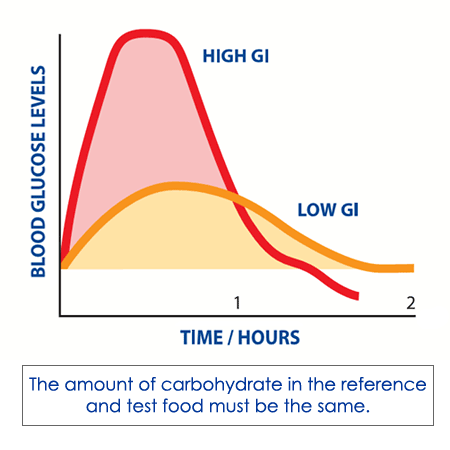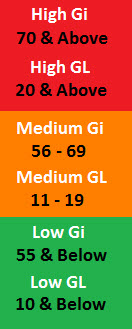Measuring a foods carbohydrate based impact during digestion and it's conversion into glucose is the foundation of the glycemic index.
Using a 100-point basis system (pure glucose has a score of 100) the GI (glycemic index) provides a numerical index to compare food types.
Foods with a higher score (70 and higher) are in the "high" category, which have the most extreme impact on sharp and long lasting blood glucose spikes. High GI foods have a direct impact on energy levels, weight management, propensity to manage diabetes, hunger, and other heath conditions.
Blood sugar, insulin, and glucose Triggers
The glycemic index is all about the quality of carbohydrates, not the amount. Actually, GI is unchanged based on portion size or amount – since the glycemic index is only concerned with measuring types of foods, not portions.
Based upon studies originated by the University of Sydney, foods have been measured and compared to evaluate their impact on insulin and conversion into glucose. Diets containing high GI foods result in a rapid spike in insulin and a volatile spike in blood glucose levels. Conversely, low and moderate GI foods result in a much narrower extreme of blood glucose, lower levels that take longer to subside.
Benefits for low glycemic foods include:
- Reduced feelings of hunger (caused by high GI insulin 'crashes')
- Mild to moderate energy increase
- Increase sensitivity and positive reaction to insulin
- May reduce the risk of heart disease + helps cardiovascular health
- Improves cholesterol levels and HDL/LDL balance
- Supports diabetes friendly nutrition
- Increases length of physical endurance & vitality
- Weight management and weight loss
Keeping Blood Sugar Constant
When your bodies blood sugar drops outside of a normal range, the most common symptoms include lethargic energy levels and an increase in hunger. When blood sugar levels rise too high, your body releases increased levels of insulin to counter the rise of sugar, which often results in a sudden drop in blood glucose from the high extreme to a low one.. The higher sugar levels are also triggered to be converted and stored as fat.
Foods with a high GI also cause this spike and crash effect, which causes more cravings for hunger and a general lack of energy.
Choosing Low GI Foods
More complex carbohydrates and foods with lower GI values take longer to digest (2-4 hours) and typically have a much more mild effect on levels of blood sugar. Examples are whole grains and most vegetables, both with relatively high levels of carbohydrates but it's the 'type' of carbs here that matter.
![black_rye_bread_588[1]](http://www.glycemicedge.com/wp-content/uploads/2010/09/black_rye_bread_5881-300x204.jpg) Avoiding simple carbohydrates, highly refined sugars, and heavily process or enriched flour based products provide a balanced digestion that lets you feel fuller for longer periods of time, avoid binges and energy crashes, and promotes healthy lipid and triglyceride levels.
Avoiding simple carbohydrates, highly refined sugars, and heavily process or enriched flour based products provide a balanced digestion that lets you feel fuller for longer periods of time, avoid binges and energy crashes, and promotes healthy lipid and triglyceride levels.
Testing over the last 2 decades, which include well published anecdotes from the University of Sydney, and tests by the American Diabetes Association and the American Heart Association have helped to improve the popularity of the health plan.
Glycemic Load vs. Glycemic Index
Unlike the glycemic index, which does not vary based on portions, a foods glycemic load is a newer adaptation of the GI that also incorporates portion size and the physical amount of the carbohydrates. It uses a foods glycemic index / 100 x net carbohydrates to calculate the load of a food per serving.
Foods with a Glycemic Load of 20 or lower are considered low or moderate. Avoid or limit foods with a net GL of > 20.
Questions about the glycemic load is one of the most common questions we receive – be sure to read our detailed GL scores and comprehensive GI and GL scores of foods on our glycemic index chart page.



i like to know why glycemic index of conflakes is high?
please reply as soon as possible
How do I determine the GI value of food (specifically Fiber One Cereal) not on the list?